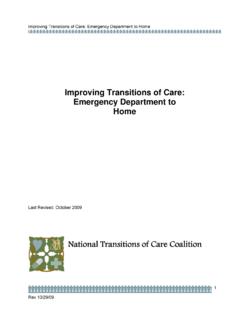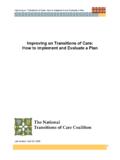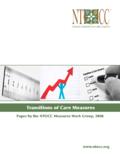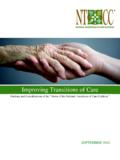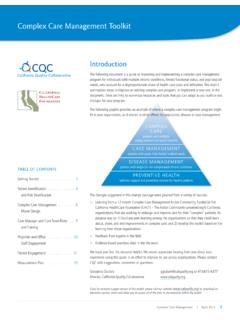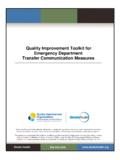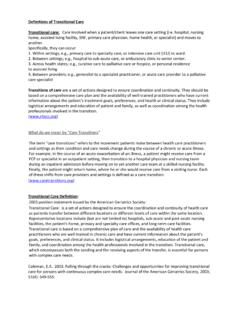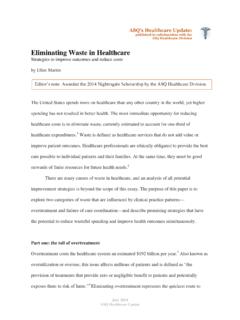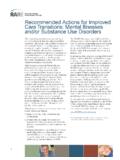Transcription of Improving Transitions of Care with Health …
1 Improving Transitions of care with Health information technology Position Paper of the Health information technology WORK GROUP for the NATIONAL Transitions OF care COALITION December 2010 December 10, 2010 Improving Transitions of care with Health information technology Table of Contents I. EXECUTIVE SUMMARY .. 2 II. INTRODUCTION .. 3 III. Health information technology BARRIERS AND GAPS IN SUPPORTING .. 6 Transitions OF care IV. POTENTIAL AREAS FOR IMPROVEMENT IDENTIFIED BY NTOCC .. 11 A. Improve communications during Transitions between providers, patients, and family caregivers B. Develop standardized processes for EMR use, including medication reconciliation C. Establish points of accountability for sending and receiving care D. Increase use of case management and professional care coordination E. Expand the role of the pharmacist in Transitions of care F. Implement payment systems that align incentives and include performance measures V.
2 CONCLUSIONS .. 27 APPENDICES Appendix A. Glossary .. 28 Appendix B. Medication Reconciliation Essential Elements .. 30 ACKNOWLEDGEMENTS December 10, 2010 SECTION I: Executive Summary Health information technology (HIT) is broadly considered a tool for Improving care quality, reducing care disparities, and Improving care outcomes, including patient and family experience. The capacity of HIT to improve communication and information sharing makes it a critical tool for addressing the threats to safety and quality during care Transitions , and it rightfully receives considerable recognition by numerous stakeholders. The American Recovery and Reinvestment Act (ARRA) of 2009 recognized the importance of HIT by allotting $19 billion toward electronic medical records in hospitals and physician offices (commonly known as the HITECH Act). In response, Health systems, professional organizations, computing companies, researchers, and others have started investing vast time, energy, and other resources toward determining an electronic system that will improve quality, increase efficiency, and in some cases, add convenience to all involved.
3 The National Transitions of care Coalition (NTOCC) believes that for HIT to make a difference in Transitions of care , the technology must address several critical steps. The components include standardized processes, good communication, required performance measures, established accountability, and strong care coordination. Without addressing each step, the promise of HIT's affect on overall transition of care improvement will not be realized. There are many barriers to the adoption of HIT and its capacity to improve Transitions of care , as well as barriers to its implementation, use, and usefulness. While Health care communities across the have made strides to research, evaluate, and examine different approaches to Improving fragmented care , widespread adoption of a reliable method to improve it is lacking. There is a significant push to adopt technology solutions to assist in Improving communication throughout the Health care community.
4 Having HIT that communicates beyond the boundaries of a single institution or Health system is critical to Improving care Transitions in the future. This document reviews the most common barriers to using HIT to improve Transitions of care . Because there is little guidance on how to use HIT in ways that specifically improve Transitions of care , this paper builds upon NTOCC's overall recommendations for Improving Transitions of care and the national agenda as it relates to HIT, and identifies problems and considerations as they relate to NTOCC's overall goals. December 10, 2010 2 SECTION II: Introduction In spite of world class clinical advancements and talent, the United States' Health and long term care system is plagued by suboptimal care quality. Problems of underuse, overuse, and misuse of Health care all contribute to these quality issues. 1 care episodes often involve numerous settings and multiple highly specialized professionals, with little or no communication between them.
5 Disparities in care quality among underserved populations are well documented and lead to exacerbated long term Health issues at both the individual and population levels. Limitations of Our Current Health care System Patients and their family caregivers experience quality problems almost every time they encounter the Health care system. Recent surveys by the National Partnership for Women & Families found that there are two very consistent pain points when interacting with the Health care system: lack of communication and lack of coordination. 2 Seventy four percent of those surveyed said that they wished their doctors talked and shared information with each other. Forty five percent said that they have had to act as a communicator between doctors who were not talking to each other. Patients and their families understand that the results of this communication and coordination void include medical errors, testing and treatment duplication, misdiagnoses, and an overall frustrating and sometimes negative care experience.
6 Patients are often sent home without the information and support needed to take care of themselves and do not receive appropriate follow up care . Evidence shows that 1 in 5 older adults with complex chronic Health conditions is readmitted within 30 days of hospital discharge. 3 This is further proof that Improving outcomes will require Improving the safety and effectiveness of care Transitions . Improvements in care are needed for all Transitions from one setting to another ( , hospital to nursing home), care Transitions within an institution ( , between units, or emergency department to hospital admission), and from a Health care setting to the care of the family and community at home ( , hospital or nursing home to home care ). 1. The Overuse, Underuse, and Misuse of Health care : Testimony before the Committee on Finance, United States Senate. (2008) (statement of Peter R. Orszag, Director, CBO). 2. Lake Research Partners for the National Partnership for Women & Families.
7 2010. 3. Jencks S, Williams M, Coleman E. Rehospitalizations among patients in the Medicare fee for service program. New Eng J Med 2009;360:1418 28. December 10, 2010 3 HIT is broadly considered a tool for Improving care quality, reducing care disparities, and Improving care outcomes, including the patient and family experience. The capacity of HIT to improve communication and information sharing makes it a critical tool for addressing the threats to safety and quality during care Transitions , and it rightfully receives considerable recognition by numerous stakeholders. In 2008, the Congressional Budget Office (CBO) published a paper that outlines the potential of HIT to improve the transfer and storage of information within the system, and goes on to identify barriers to its adoption. 4 The benefits of HIT and improvements in efficiency noted include: Eliminating paper medical records and expanding the exchange of Health information Avoiding duplicate or unnecessary diagnostic tests and radiological services Promoting cost effective use of prescription drugs and avoiding adverse drug events Improving nurse and physician productivity Reducing hospital length of stay Improving quality of care and expansion of the practice of evidence based medicine Generating research data on comparative effectiveness and cost effectiveness of treatments It further outlines the evidence on costs associated with implementing HIT in physicians' offices and hospitals.
8 Finally, it describes the evidence regarding the many challenges related to the adoption of HIT. In many instances, physicians will change the way they practice medicine, and radical changes require organizational commitment along with financial investment. Many complex decisions must be made with regard to technology , such as hardware capabilities and interoperability, software vendors and languages, and rapidly changing technology . Further, many small providers are finding it difficult to make the business case for investing in HIT due to misaligned incentives. The American Recovery and Reinvestment Act (ARRA) of 2009 recognized the importance of HIT by allotting $19 billion toward the use of electronic medical records in hospitals and physician offices (commonly known as the HITECH Act).5 In response, Health systems, professional organizations, computing companies, researchers, and others have started investing vast time, energy, and other resources toward shaping an electronic system that will improve quality, increase efficiency, and in some cases, add convenience to all involved.
9 The Act authorizes CMS to provide reimbursement incentives for eligible professionals and hospitals who are successful in becoming meaningful users of certified electronic Health record (EHR) technology . The work of the Health information technology Policy Committee, the Office of the National Coordinator (ONC), and the Centers for Medicare & Medicaid Services, which has recently culminated in a final rule outlining the definition of the 4. Congressional Budget Office. Evidence on the Costs and Benefits of Health information technology . (May 2008) 5. Health information technology for Economic and Clinical Health (HITECH) Act, Title XIII of Division A and Title IV of Division B of the American Recovery and Reinvestment Act of 2009 (ARRA), Pub. L. No. 111 5 (Feb. 17, 2009). December 10, 2010 4 meaningful use basis, clearly articulates the meaningful use of Health information technology as a critical foundation for reform. 6 The Patient Protection and Affordable care Act of 2010, the Health care reform law enacted in March 2010, also contains multiple provisions related to the use of technology to facilitate safer, more effective, and higher quality Health care .
10 7 The kind of patient centered Health care that individuals want and deserve will not be possible without using technology to support its delivery. Improving Outcomes By Ensuring Effective Transitions Of care One of the primary benefits of using technology in delivering Health care is the ability to ensure that the right information is available at all stages of the Health care process, especially during critical times of transition . All members of the Health care team including patients and their family caregivers need access to key pieces of information in order to make Transitions of care smooth, safe, and effective. NTOCC has described several steps that are critical to achieving this kind of information sharing: Improve communication during Transitions between providers, patients, family caregivers and community supports; Develop standardized processes for medication reconciliation and care coordination; Establish accountability for sending, receiving and acting upon information necessary for safe, effective Transitions of care ; Increase the use of case management and professional care coordination; Expand the role of the pharmacist in medication reconciliation in Transitions of care ; Develop performance measures to encourage better Transitions of care ; and Implement payment systems that align incentives.
